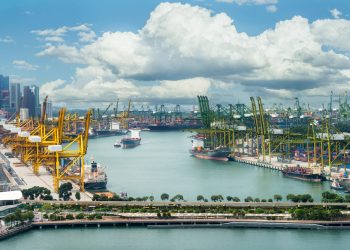MPA Singapore announced that Mr Khaw Boon Wan, Coordinating Minister for Infrastructure and Minister for Transport, participated in the installation of the 221st and final caisson for Tuas Terminal Phase 1 reclamation on April 23. When the project is done, PSA Corporation will begin terminal development of deep-water berths that are able to handle about 20 million twenty-foot equivalent units (TEUs) per annum.
Specifically, the Phase 1 reclamation began in 2015. The three-quarters of the project are already completed, based o schedule and the overall project is to be finished in 2021.
The use of caissons in Phase 1 is a safe and more efficient way of reclamation in comparison to the traditional ones, as piling. The caissons used for Tuas Terminal’s construction are one of the largest in the world.
Pre-fabricated onsite, the caissons each weighs 15,000 tonnes and measures 40m in length, 28m in width and 28m in height – as tall as a 10-storey building.
As Mr Khaw Boon Wan commented
Our Mega Port project at Tuas will transform our port operation, to position ourselves for the future. The project itself is a mega infrastructure project, and hence, an opportunity to transform our construction and reclamation industry. We have been reclaiming from the sea since independence.
He continued that the Tuas reclamation project is not more of the same; it applies complex state-of-the-art engineering expertise, using caissons for higher efficiency and safety. Each caisson weighs 15,000 tonnes and is a 10-storey giant.
MPA Singapore along with Dredging International Asia Pacific – Daelim Joint Venture and Surbana Jurong used innovative methods with a variety from the pre-installation of geotextiles on caissons on land instead of at sea, and the use of artificial intelligence to the use of drones for site survey and progress monitoring.
In particular, there are two innovations, which have pushed the frontiers of engineering:
- Temarock: a next generation all-in-one rock mound construction vessel. The conventional process of rock mound construction requires multiple vessels for rock laying and compaction, one survey vessel to facilitate operation, and is supported by divers. TEMAROCK automates these tasks, eliminating the need for multiple vessels or divers’ assistance. This enhances efficiency and safety.
- Automatic Rebar Machine using Robotics System (ARMS): automates the bending and cutting of reinforcement steel bars (or rebars, which are used to strengthen concrete) to the desired design, and then transfers them onto the stacking area. The conventional practice requires workers to handle the rebar manually, which exposes them to mechanical hazards when they operate the rebar cutting and bar bending machines.
Concluding, the Tuas Terminal is to begin operations from 2021. It will be fully-completed in 2040 and will consolidate all port operations in a single location and be capable of handling up to 65 million TEUs annually.






























































